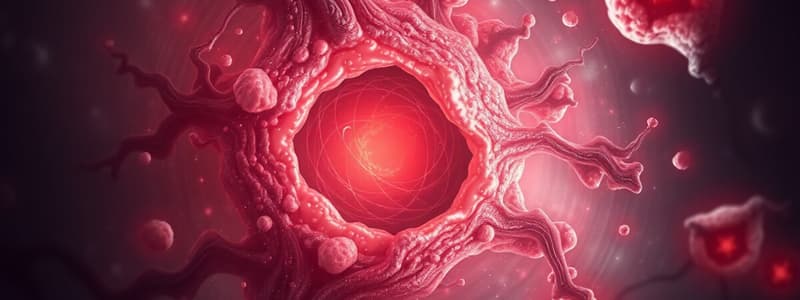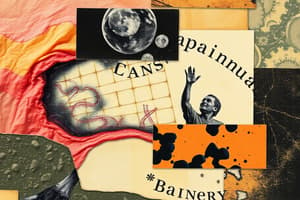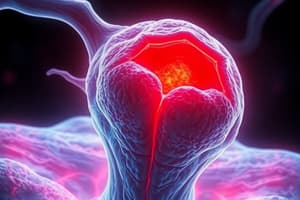Podcast
Questions and Answers
What primarily replaces neutrophils within 48 to 96 hours during tissue repair?
What primarily replaces neutrophils within 48 to 96 hours during tissue repair?
- Macrophages (correct)
- Basophils
- Eosinophils
- Lymphocytes
What is a key feature of scar formation after a wound healing?
What is a key feature of scar formation after a wound healing?
- Enhanced leukocytic infiltrate
- Persistence of edema
- Increased vascularity
- Blanching due to collagen accumulation (correct)
During wound contraction, what is primarily reduced?
During wound contraction, what is primarily reduced?
- The gap between dermal edges (correct)
- The number of fibroblasts
- The blood flow to the area
- The size of the scar tissue
What type of repair tissue is formed in healing a fracture?
What type of repair tissue is formed in healing a fracture?
What characterizes woven bone compared to lamellar bone?
What characterizes woven bone compared to lamellar bone?
What happens during stage 1 of fracture healing?
What happens during stage 1 of fracture healing?
Which of the following occurs during the inflammation stage of fracture healing?
Which of the following occurs during the inflammation stage of fracture healing?
What is the primary process by which lost tissue is replaced by similar tissue?
What is the primary process by which lost tissue is replaced by similar tissue?
Which type of wound involves the skin being split or cracked?
Which type of wound involves the skin being split or cracked?
Labile cells have a high capacity for regeneration. Which of the following is an example of labile cells?
Labile cells have a high capacity for regeneration. Which of the following is an example of labile cells?
Which cells are categorized as having a low level of replication but can proliferate in response to injury?
Which cells are categorized as having a low level of replication but can proliferate in response to injury?
Which type of cells cannot be replaced if lost due to their non-dividing nature?
Which type of cells cannot be replaced if lost due to their non-dividing nature?
What determines whether healing occurs by regeneration or repair?
What determines whether healing occurs by regeneration or repair?
Which of the following represents a closed wound?
Which of the following represents a closed wound?
Which type of healing involves the formation of scar tissue?
Which type of healing involves the formation of scar tissue?
What effect does early motion have on wound healing?
What effect does early motion have on wound healing?
How does prior irradiation affect wound healing?
How does prior irradiation affect wound healing?
What condition often contributes to delayed wound healing in older adults?
What condition often contributes to delayed wound healing in older adults?
Which of the following is true about systemic infections?
Which of the following is true about systemic infections?
What is a common complication associated with deficient scar formation?
What is a common complication associated with deficient scar formation?
What role does diabetes mellitus play in wound healing?
What role does diabetes mellitus play in wound healing?
How do anti-inflammatory drugs affect wound healing?
How do anti-inflammatory drugs affect wound healing?
What is the result of inadequate formation of granulation tissue?
What is the result of inadequate formation of granulation tissue?
Which factor is NOT associated with poor wound healing?
Which factor is NOT associated with poor wound healing?
What does wound dehiscence refer to?
What does wound dehiscence refer to?
What are the two main objectives of wound healing?
What are the two main objectives of wound healing?
Which of the following is NOT part of the processes involved in wound healing?
Which of the following is NOT part of the processes involved in wound healing?
What is the primary function of growth factors in the healing process?
What is the primary function of growth factors in the healing process?
Which source of growth factors is activated after endothelial damage?
Which source of growth factors is activated after endothelial damage?
What term describes the mechanical reduction in the size of a wound defect?
What term describes the mechanical reduction in the size of a wound defect?
Which factor does NOT influence the capacity of a tissue for regeneration?
Which factor does NOT influence the capacity of a tissue for regeneration?
What leads to a faster healing process during wound healing?
What leads to a faster healing process during wound healing?
Which of the following processes occurs during wound healing?
Which of the following processes occurs during wound healing?
What happens when wound contraction is prevented?
What happens when wound contraction is prevented?
What defines the renewal of lost tissue with identical cells?
What defines the renewal of lost tissue with identical cells?
What is the role of myofibroblasts in wound healing?
What is the role of myofibroblasts in wound healing?
Which event occurs first within the first 24 hours after a surgical incision?
Which event occurs first within the first 24 hours after a surgical incision?
What pattern of wound healing describes a clean surgical incision that is well approximated by sutures?
What pattern of wound healing describes a clean surgical incision that is well approximated by sutures?
After how many days does granulation tissue typically fill the incision space?
After how many days does granulation tissue typically fill the incision space?
What changes in the wound occur approximately two weeks post-surgery?
What changes in the wound occur approximately two weeks post-surgery?
What is a characteristic of scar tissue formed after one month of wound healing?
What is a characteristic of scar tissue formed after one month of wound healing?
Which cellular process primarily takes place during the second and third days of healing by first intention?
Which cellular process primarily takes place during the second and third days of healing by first intention?
What occurs within 24-48 hours after the injury process?
What occurs within 24-48 hours after the injury process?
Which of the following best describes healing by second intention?
Which of the following best describes healing by second intention?
What cellular change is expected around the fifth day post-injury?
What cellular change is expected around the fifth day post-injury?
Flashcards
Wound Healing
Wound Healing
The body's process of replacing destroyed tissue with living tissue.
Wound
Wound
A breach or defect in living tissue caused by injury, accompanied by inflammation.
Closed Wound
Closed Wound
A wound where the skin is intact, but underlying tissues are damaged. Examples include contusions, hematomas, and pressure ulcers.
Open Wound
Open Wound
Signup and view all the flashcards
Regeneration
Regeneration
Signup and view all the flashcards
Repair (healing by scarring)
Repair (healing by scarring)
Signup and view all the flashcards
Labile cells
Labile cells
Signup and view all the flashcards
Permanent cells
Permanent cells
Signup and view all the flashcards
Wound Healing Objectives
Wound Healing Objectives
Signup and view all the flashcards
Wound Healing Processes
Wound Healing Processes
Signup and view all the flashcards
Growth Factors in Healing
Growth Factors in Healing
Signup and view all the flashcards
Growth Factor Sources
Growth Factor Sources
Signup and view all the flashcards
Healing by Regeneration
Healing by Regeneration
Signup and view all the flashcards
Regeneration Process
Regeneration Process
Signup and view all the flashcards
Factors Affecting Regeneration
Factors Affecting Regeneration
Signup and view all the flashcards
Wound Contraction
Wound Contraction
Signup and view all the flashcards
Benefits of Wound Contraction
Benefits of Wound Contraction
Signup and view all the flashcards
Cause of Wound Contraction
Cause of Wound Contraction
Signup and view all the flashcards
Myofibroblasts
Myofibroblasts
Signup and view all the flashcards
Wound Healing by First Intention
Wound Healing by First Intention
Signup and view all the flashcards
Healing by Second Intention
Healing by Second Intention
Signup and view all the flashcards
Fibrin Clot
Fibrin Clot
Signup and view all the flashcards
Granulation Tissue
Granulation Tissue
Signup and view all the flashcards
Epithelialization
Epithelialization
Signup and view all the flashcards
Scar Tissue
Scar Tissue
Signup and view all the flashcards
What is the primary function of myofibroblasts in wound healing?
What is the primary function of myofibroblasts in wound healing?
Signup and view all the flashcards
How do epithelial cells contribute to wound healing?
How do epithelial cells contribute to wound healing?
Signup and view all the flashcards
Why does healing by second intention result in larger scars compared to healing by first intention?
Why does healing by second intention result in larger scars compared to healing by first intention?
Signup and view all the flashcards
Macrophage Role in Healing
Macrophage Role in Healing
Signup and view all the flashcards
Scar Formation Stages
Scar Formation Stages
Signup and view all the flashcards
Wound Contraction Purpose
Wound Contraction Purpose
Signup and view all the flashcards
Bone vs. Soft Tissue Healing
Bone vs. Soft Tissue Healing
Signup and view all the flashcards
Bone Structure
Bone Structure
Signup and view all the flashcards
Woven Bone
Woven Bone
Signup and view all the flashcards
Lamellar Bone
Lamellar Bone
Signup and view all the flashcards
Early Motion and Healing
Early Motion and Healing
Signup and view all the flashcards
Radiation and Healing
Radiation and Healing
Signup and view all the flashcards
Circulation and Healing
Circulation and Healing
Signup and view all the flashcards
Infection and Healing
Infection and Healing
Signup and view all the flashcards
Diabetes and Healing
Diabetes and Healing
Signup and view all the flashcards
Protein Deficiency and Healing
Protein Deficiency and Healing
Signup and view all the flashcards
Anti-inflammatory Drugs and Healing
Anti-inflammatory Drugs and Healing
Signup and view all the flashcards
Wound Dehiscence
Wound Dehiscence
Signup and view all the flashcards
Wound Ulceration
Wound Ulceration
Signup and view all the flashcards
Incisional Hernias
Incisional Hernias
Signup and view all the flashcards
Study Notes
Wound Healing
- Healing, in a pathological context, is the body's replacement of damaged tissue with living tissue.
- A wound is a breach or defect in intact living tissue, caused by injury and accompanied by inflammation.
- Wounds can be accidental or surgical.
Types of Wounds
- Closed Wounds: Skin surface is intact, but underlying tissues are damaged (e.g., contusions, hematomas, Stage 1 Pressure Ulcers).
- Open Wounds: Skin is split or cracked, exposing underlying tissues to the environment.
Processes of Wound Healing
- Regeneration: Replacement of lost tissue with similar tissue types.
- Repair (healing by scarring): Replacement of lost tissue with granulation tissue that matures into a scar.
- Healing type depends on the damaged organ's cell type and stromal framework integrity.
Types of Cells
- Labile Cells: High proliferative capacity, found in surface epithelium of GI tract, urinary tract, and skin; lymphoid and hematopoietic cells; excellent regeneration potential.
- Stable Cells: Lower replication rates, few stem cells; can undergo rapid division in response to injury; smooth muscle cells, fibroblasts, osteoblasts, endothelial cells; good regeneration potential. Liver, endocrine glands, and renal tubular epithelium can regenerate.
- Permanent Cells: Non-dividing; cannot be replaced if lost; adult neurons, striated muscle cells, lens cells.
Objectives of Wound Healing
- Restore an intact epithelial surface.
- Restore tensile strength of sub-epithelial tissue.
- Wound healing is a complex, orderly, systematic process that involves seven processes:
- Acute inflammatory response upon injury
- Regeneration of native cells of tissue involved.
- Proliferation and migration of native and connective tissue cells.
- Synthesis of extracellular matrix (ECM) proteins.
- Remodelling of connective tissue and parenchymal components.
- Collagenization and progressive acquisition of wound strength.
- Contraction.
Growth Factors
- Healing is, in part, mediated by growth factors—low molecular weight polypeptides stimulating cell division and proliferation.
- Sources of growth factors include platelets, circulating serum growth factors, macrophages, and lymphocytes recruited to the injury site.
Healing by Regeneration
- Regeneration is the renewal of lost tissue by replacing lost cells with identical ones.
- It involves two processes: proliferation of surviving cells to replace lost tissue and migration of surviving cells into the vacant space.
- Regenerative capacity depends on tissue's proliferative ability, degree of damage, and damage severity.
Wound Contraction
- Mechanical reduction in wound size, typically 70-80% of original size.
- Faster healing due to reduced tissue needing replacement.
- Slow and large ugly scar formation if prevented.
- Myofibroblasts—features intermediate between fibroblasts and smooth muscle cells—cause contraction.
- Migrate to wound site 2-3 days post-injury, decreasing wound area.
Patterns of Wound Healing
- Healing by First Intention (Primary Union): Clean, uninfected surgical wounds with well-approximated sutures heal quickly. Minimal epithelial and connective tissue cell death; minimal basement membrane disruption. Immediately filled by clotted blood which dehydrates to form scab.
- Healing by Second Intention: Extensive cell loss, large tissue defects; wide margins; includes infarction, inflammatory ulceration, and abscesses. Requires abundant granulation tissue, more fibrin, necrotic debris, and a significant inflammatory reaction for healing. Myofibroblasts are important for wound contraction, which is critical for healing large wounds.
Granulation Tissue
- New connective tissue with microscopic blood vessels and myofibroblasts forming at wound site during healing.
- Fills wound spaces; crucial for wound contraction and epithelial cell migration.
Factors Influencing Wound Healing
- Local Factors: Type, size, location of wound, vascular supply, infection, movement, ionizing radiation.
- Systemic Factors: Circulatory status, infection, metabolic status, nutritional deficiencies, anti-inflammatory drugs.
Complications of Wound Healing
- Infection: A wound provides a portal of entry for microorganisms and delays or stops healing. Severe infection may cause extensive granulation tissue formation (proud flesh) and possible large, deforming scars.
- Deficient Scar Formation: Inadequate granulation tissue formation or inability to form suitable extracellular matrix; leads to;
- Wound dehiscence and incisional hernias: Improper sutures, infection; increased mechanical stress by vomiting, coughing, or ileus are risk factors.
- Ulceration: Inadequate blood supply, insufficient vascularization, and persistent trauma may lead to ulceration. Commonly found in diabetics, leprosy, and tertiary syphilis.
- Excessive Scar Formation: Excessive extracellular matrix deposition; leads to:
- Hypertrophic scars: Raised or thickened scar tissue.
- Keloids: Prominent, raised scar tissue extending beyond the wound boundaries.
- Contractures: Excessive wound contraction; can restrict movement or function.
Fracture Healing
- Unlike skin wounds, fracture healing involves specialized bone-forming tissue.
- Bone is comprised of calcified osteoid tissue (collagen and osteomucin matrix)
- Woven (immature/non-lamellar) bone shows collagen bundle irregularity.
- Lamellar (adult) bone has parallel collagen bundles in sheets.
- Fracture healing process occurs in seven stages, including hematoma formation, inflammation, demolition, granulation tissue formation, woven bone/cartilage formation, lamellar bone formation, and remodeling.
Studying That Suits You
Use AI to generate personalized quizzes and flashcards to suit your learning preferences.



